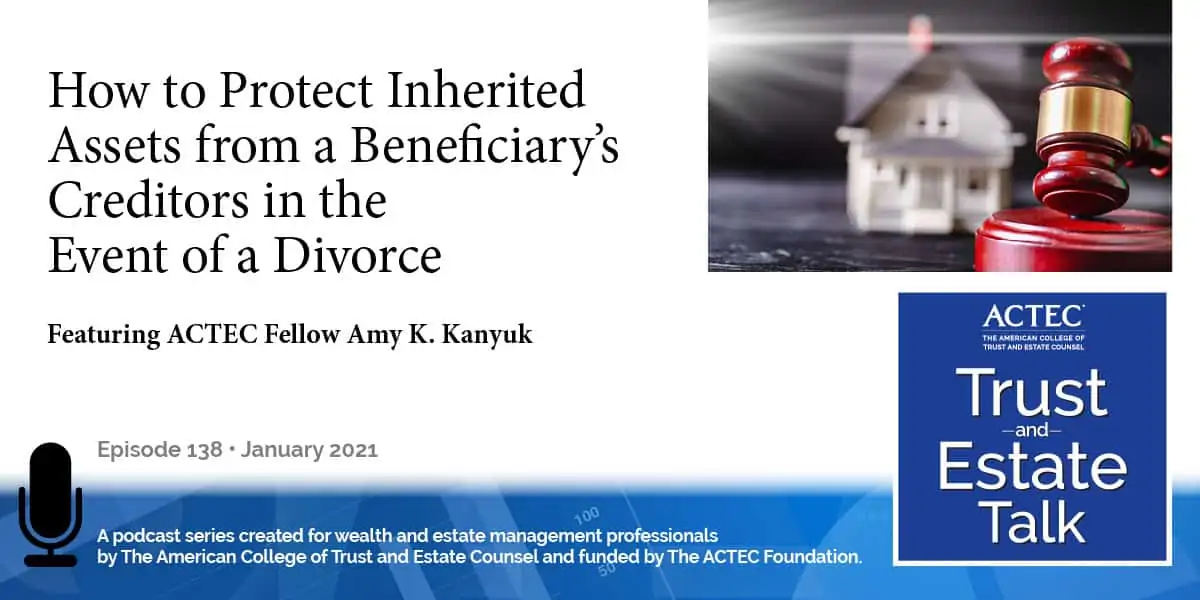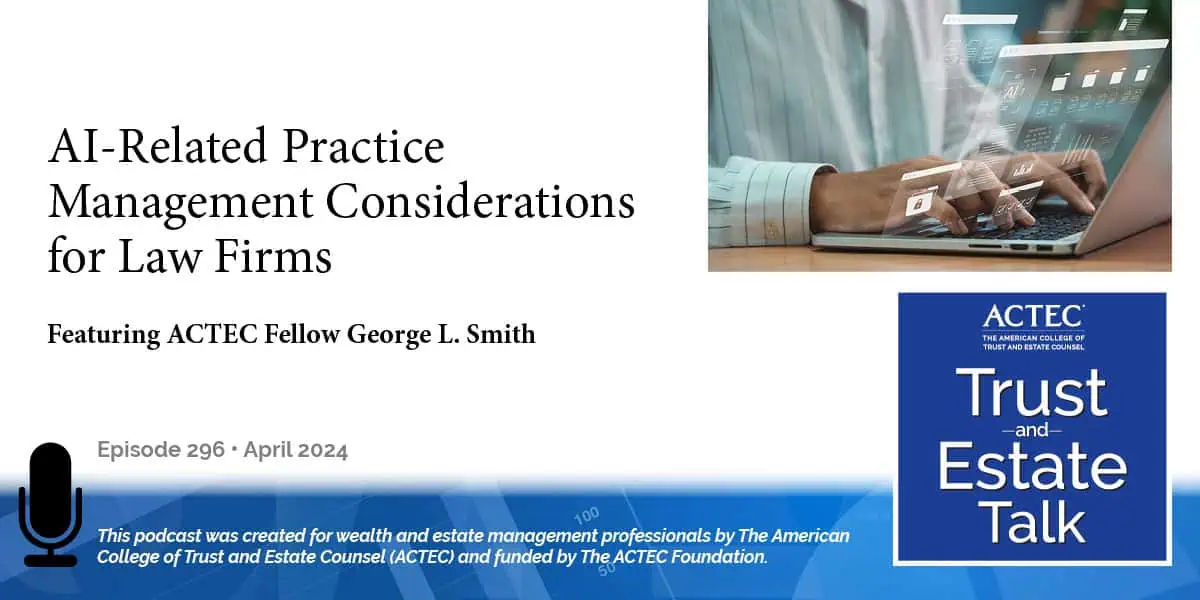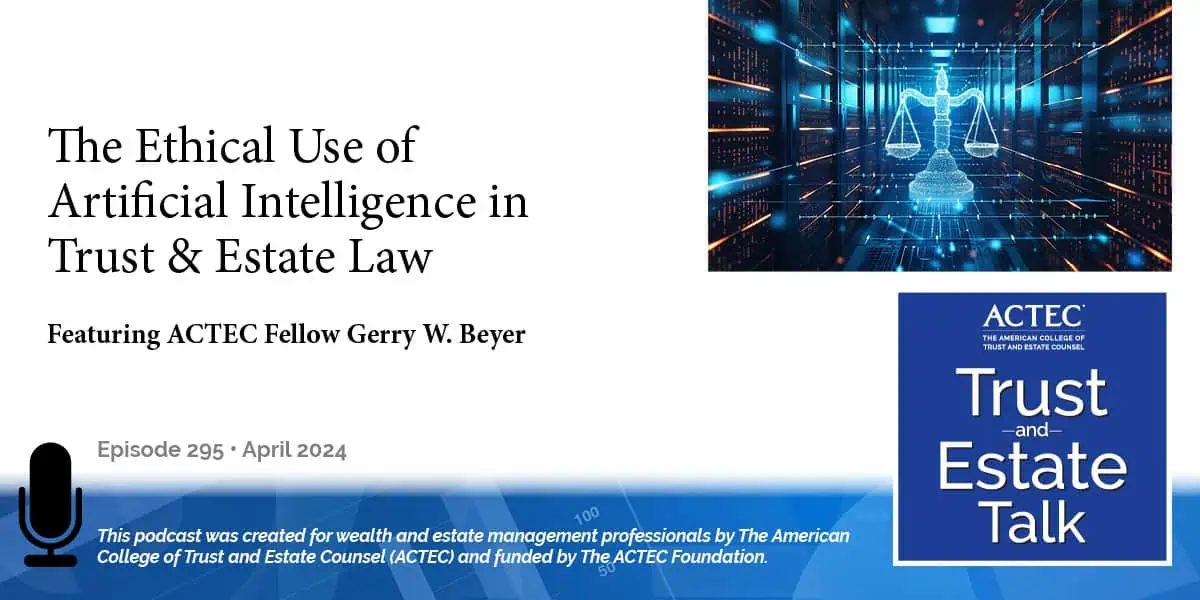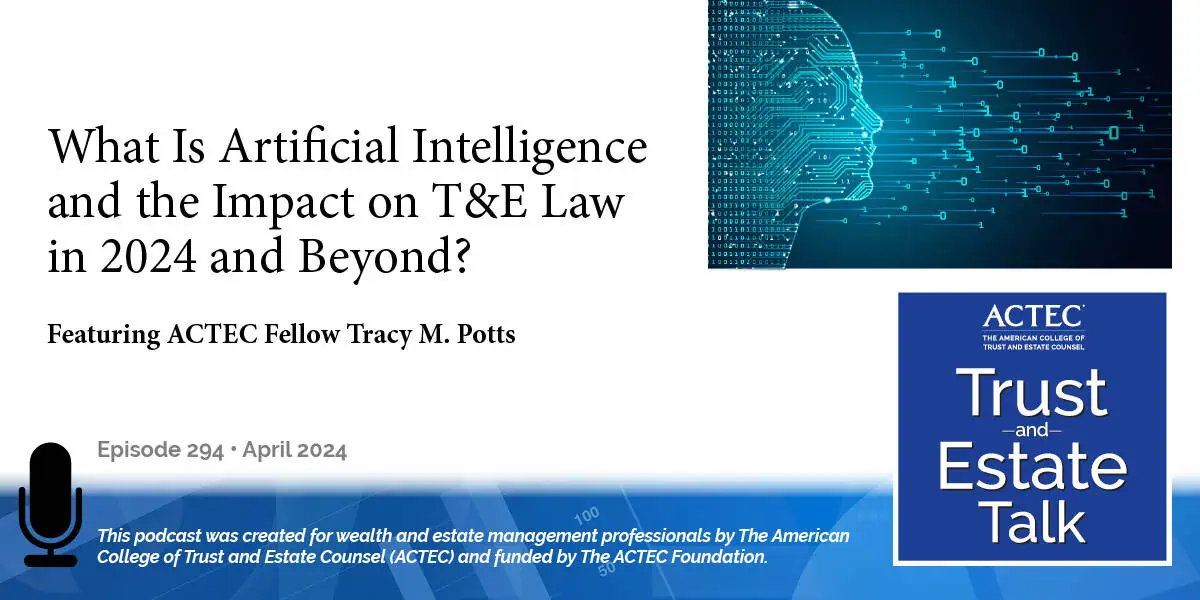How to Protect Inherited Assets from a Beneficiary’s Creditors in the Event of a Divorce

“How to Protect Inherited Assets from a Beneficiary’s Creditors in the Event of a Divorce,” that’s the subject of today’s ACTEC Trust and Estate Talk.
Transcript/Show Notes
This is Susan Snyder, ACTEC Fellow from Chicago. The grantor of a trust doesn’t want a beneficiary’s interest in the trust to be subject to the claims of creditors, especially when the creditor is a divorcing spouse. To educate us more on this topic you’ll be hearing today from ACTEC Fellow, Amy Kanyuk of Concord, New Hampshire. Welcome, Amy.
Today we’re going to focus on how to help clients structure trusts so that the inheritances they leave for their children and further descendants are protected in the event of a divorce. When people get divorced, their marital property is generally divided equally between them. But what constitutes marital property depends on state law. In some states, all of the couple’s property, regardless of its source, is divided between the spouses. But other states distinguish between marital and separate property and count inherited assets as separate property that isn’t subject to division. The problem, of course, is that even if we know where the client is living when he or she is creating the trust, we may not know where a beneficiary is going to be when he or she gets divorced. So, you want to structure the plan to maximize the protection of the trust assets, regardless of where people happen to be living when the marriage ends.
First and foremost, what the client should avoid, if possible, is including in a trust agreement, a mandatory distribution or withdrawal right. If a beneficiary can, as a matter of right, access trust property, the beneficiary’s creditors can almost always access it too, either directly from the trustee or from the beneficiary when the money is distributed from the trust to the beneficiary. So, you’d want to avoid, if possible, giving beneficiaries mandatory income rights, withdrawal powers, and lifetime general powers of appointment. You also should try to avoid mandatory distribution provisions, like giving a beneficiary the power to withdraw trust property in stages over time. For example, a third at 30, half at 35, and the balance at 40. However, these tend to be the types of provisions that clients actually want to include in their trust. So, we need to find a way to draft the trust to minimize the exposure of the trust assets in a divorce, but still keep the client happy.
You could start out by including a spendthrift provision in the trust agreement. That provision prohibits the beneficiary from assigning or transferring his interest in a trust and prevents a creditor from collecting a claim directly from the trustee. In other words, the creditor can only attempt to collect from the beneficiary after the beneficiary has received the distribution.
You also should think about including a provision that specifically states that nonbeneficiaries have no rights in the trust. In other words, that the trust property is available only to the beneficiaries of the trust to the exclusion of any other person, including a spouse in the event of divorce. When interpreting a trust agreement, the grantor’s intent is the controlling factor. So, the more you can demonstrate in the agreement that the grantor intends to protect the trust property from the beneficiary’s creditors, the more you’re going to help the trustee and the more protection you can provide to the beneficiaries.
The alternative to mandatory distribution provisions is giving the trustee discretion to make distributions to the beneficiaries. If the distributions are made solely in the trustee’s discretion, then the beneficiaries don’t have property interests that can be attached by their creditors. They have mere expectancies that, perhaps, one day the trustee will give them some money. Very broad discretion can be problematic only because the trustee may not know when or how to exercise the discretion. So, for that reason, it can be helpful to include in the trust agreement nonbinding precatory language to give the trustee some idea of the circumstances under which the grantor envisions the trustee would exercise its discretion to distribute.
For example, if the grantor really wants the beneficiaries to get the income from the trust, or a certain percentage of the value of the trust each year, the precatory language could encourage rather than require the trustee to make those distributions. But the trustee should avoid a regular pattern of discretionary distributions because those could, in a divorce, be interpreted by a judge as a property right that will cause the trust assets to somehow come into play in a property settlement.
If providing guidance to the trustee and the trust agreement itself isn’t desirable or isn’t possible, the grantor could consider providing the trustee with a letter of wishes about the grantor’s intent. A letter of wishes can be changed as the grantor’s thoughts change. So, it can provide some flexibility to the grantor.
Some people, in an effort to put some structure around language of discretion, make the trustee’s exercise of discretion subject to a standard; and usually that is the ascertainable standard of health, support, maintenance and education. When you mix absolute discretion with a standard, though, you can create confusion and possibly unnecessarily expose the property to creditors; because the spouse and the divorce judge may focus on the ascertainable standard and won’t understand that that standard is meant to guide the trustee’s exercise of discretion, not to create a property right. Although you need an ascertainable standard if a beneficiary is going to be the trustee, you generally don’t need one in other situations. And to me, in those situations, it’s better to leave out the ascertainable standard and put in precatory language to guide the trustee.
Having multiple beneficiaries also can provide protection. For example, instead of making the client’s child the sole beneficiary of the trust, consider making the trust a sprinkle trust of which the child and the child’s descendants are eligible to receive discretionary distributions. If the client really wants the child to be the sole beneficiary, you can start out that way and then give someone — probably a trust protector — the power to add beneficiaries to the trust, such as the child’s descendants. If the trust has multiple beneficiaries, then the child can be identified as the primary beneficiary to give the trustee some guidance on how to exercise its discretion, as long as you specifically authorize the trustee to make distributions to some but not all of the beneficiaries and to make distributions of different amounts to different beneficiaries. That will help avoid a claim by the child’s spouse that the trustee is breaching its duties, if it’s distributing trust property to the other beneficiaries but not to the child.
You also could authorize the trustee to decant the trust assets, because the trustee could exercise this power to eliminate or modify the exposed beneficial interests. Keep in mind, though, that decanting is a fiduciary power. So, this trust agreement should specifically authorize the trustee to decant under these circumstances.
The choice of trustee is always important, but it’s especially important when viewed through the lens of creditor protection for the beneficiaries. The safest bet is using a sole disinterested trustee who has discretionary distribution powers. If at some point a beneficiary becomes entitled to an outright distribution of trust property, for example, when reaching a certain age or when the trust terminates, that property is subject to the beneficiary’s creditors. If that happens, you can give the trustee the power to withhold, in a further trust, property that is subject to the outright distribution.
Most, if not all, states have statutes that require a trustee to inform and report to the beneficiary. In some of those states, those rules are default provisions that can be modified or eliminated in the trust agreement. If that’s the case in your jurisdiction, consider giving the disinterested trustee the power to suspend or terminate the beneficiary’s right to receive accountings, if the trustee thinks that receiving the information wouldn’t be in the beneficiary’s best interest. If the beneficiary can’t access the information, impossibility of performance should be a complete defense to a demand by the beneficiary’s spouse for information about the trust; and the judge hearing the divorce case won’t have jurisdiction over the trustee to compel an accounting.
Protecting trust assets from a beneficiary’s creditors is a complicated subject that also has tax consequences. However, thoughtful planning will allow the beneficiary to enjoy the trust property while still protecting it.
Thanks Amy, for teaching us about creditors’ rights against a beneficiary involved in a divorce.
Other podcasts of interest:
This podcast was produced by The American College of Trust and Estate Counsel, ACTEC. Listeners, including professionals, should under no circumstances rely upon this information as a substitute for their own research or for obtaining specific legal or tax advice from their own counsel. The material in this podcast is for information purposes only and is not intended to and should not be treated as legal advice or tax advice. The views expressed are those of speakers as of the date noted and not necessarily those of ACTEC or any speaker’s employer or firm. The information, opinions, and recommendations presented in this Podcast are for general information only and any reliance on the information provided in this Podcast is done at your own risk. The entire contents and design of this Podcast, are the property of ACTEC, or used by ACTEC with permission, and are protected under U.S. and international copyright and trademark laws. Except as otherwise provided herein, users of this Podcast may save and use information contained in the Podcast only for personal or other non-commercial, educational purposes. No other use, including, without limitation, reproduction, retransmission or editing, of this Podcast may be made without the prior written permission of The American College of Trust and Estate Counsel.
If you have ideas for a future ACTEC Trust & Estate Talk topic, please contact us at ACTECpodcast@ACTEC.org.
© 2018 – 2024 The American College of Trust and Estate Counsel. All rights reserved.
Latest ACTEC Trust and Estate Talk Podcasts

AI-Related Practice Management Considerations for Law Firms
A discussion for law firms about how to incorporate AI in their practice management, including staff considerations, the “billable hour,” and more.

The Ethical Use of Artificial Intelligence in Trust & Estate Law
A law professor offers insights into the risks, rewards, duties and ethical considerations of lawyers using AI in their T&E practices.

What Is Artificial Intelligence and the Impact on T&E Law in 2024 and Beyond?
A primer on the types and uses of AI, then a deeper dive into the impact on trust and estate law from types to applications to ethical considerations.

